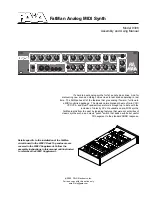
10. THE SEQUENCER
46
locked trig will begin to flash rapidly, indicating the trig now contains a parameter lock. Remove a single
parameter lock by holding
[TRIG]
+ pressing the
DATA ENTRY
knob of the locked parameter. By remov-
ing a note trig and entering it again, all parameter locks will be erased from the trig.
In LIVE RECORDING mode, turning a
DATA ENTRY
knob will input parameter locks to the active track.
Note trigs will be locked accordingly, and lock trigs containing the parameter locks will be placed on the
sequencer steps that do not have note trigs.
To remove the parameter locks of all tracks while LIVE RECORDING mode is active, press and hold
[FUNC]
+
[NO]
. Sound locks will however not be erased. Remove specific parameter locks in real time
by pressing
[NO]
while pressing the
DATA ENTRY
knob corresponding to the parameter that will be
removed.
Up to 128 different parameters can be locked in a pattern. A parameter counts as one (1)
locked parameter no matter how many trigs that lock it. If for example the cutoff parame-
ter of the ladder filter of synth track 1 is locked on every sequencer step, there are still 127
other parameters that can be locked.
10.12.2 SOUND LOCKS
All Sounds residing in the Sound pool of the active project can be changed per sequencer step, which
is an immensely useful feature for adding variations to a track. Press and hold a note trig and turn the
TRACK LEVEL
knob. The Sound pool list will appear. Scroll the list using the
TRACK LEVEL
knob, select
the Sound you want to assign to the note trig and then release the
[TRIG]
key. The
[TRIG]
key will start
to flash. Pressing and holding the
[TRIG]
key of the note trig will show the assigned Sound.
10.12.3 CONDITIONAL LOCKS
On the NOTE page, there is a parameter called
TRC
(Trig Condition) with which a set of conditional rules
can be applied to any trig, using a parameter lock. Each setting is a logical condition that will deter-
mine whether a trig set in the sequencer will be triggered or not. If the condition is true then the trig will
become active and affect the sequence. You must first place a trig on the sequencer step to where you
want to apply a conditional lock.
The sequencer needs to be in FILL mode to activate the conditional lock called FILL. For more informa-
tion, please see “10.12.4 FILL MODE” on page 47.
You can set the following trig conditions:
FILL
is true (activates the trig) when FILL mode is active.
FILL
is true when FILL is false. A trig with this trig condition is active when you are not in FILL mode.
PRE
is true if the most recently evaluated trig condition on the same track was true. (PRE and PRE
conditions are ignored and not evaluated.)
PRE
is true when PRE is false. A trig with this trig condition is active if the most recently evaluated trig
condition on the same track was not true. (PRE and PRE conditions are ignored and not evaluated.)
Example 1: Trig 1, 50% =
True
> Trig 2, PRE =
False
> Trig 3, PRE =
False
> Trig 4, PRE =
True
Example 2: Trig 1, 50% =
False
> Trig 2, PRE =
True
> Trig 3, PRE =
True
> Trig 4, PRE =
False
NEI
is true if the most recently evaluated trig condition on the neighbor track was true. (PRE and
PRE conditions on the neighbor track are ignored and not evaluated.) The neighbor track is the track
before the active track. For example, track 3 is the neighbor track of track 4. NEI and NEI conditional
trigs on track 4 evaluate the conditional trigs placed on track 3. The NEI condition is false if no condi-
tional trigs exist on the neighbor track.
NEI
is true when NEI is false. A trig with this trig condition is active if the most recently evaluated trig
condition on the neighbor track was not true. (PRE and PRE conditions on the neighbor track are
ignored and not evaluated.)
1ST
is true the first time the pattern plays (when looped).
Содержание Analog Four MKII
Страница 1: ...Analog Four MKII Digital mind analog soul User Manual...
Страница 9: ...TABLE OF CONTENTS 9...
Страница 107: ......
Страница 108: ...8062ENG A...











































